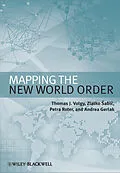This groundbreaking study maps out and analyzes the development of
a global intergovernmental (IGO) institutional architecture in the
post World War II era.
* Systematically traces similarities and differences between the
institutional architecture of the Cold War and post-Cold War
eras
* Examines the range of reasons why states join IGOs, identifies
patterns of participation within these organizations, and examines
the effects of membership on states
* Considers the impact of the EU on other regional organizations
and developments outside Europe
* Provides a strong contribution to the study of international
organization and IGO development combining both quantitative and
qualitative methodologies
Autorentext
Thomas J. Volgy is Professor of Political Science at the
University of Arizona, and Executive Director of the International
Studies Association. He has previously worked for USAID, USIA, and
the National Democratic Institute in Central Asia, Eastern Europe,
and Central America, and was recently an Atlantic Fellow.
Zlatko Sabic is Professor of International
Relations at the University of Ljubljana and Senior Research Fellow
at the Centre of International Relations.
Petra Roter is Assistant Professor of International
Relations at the University of Ljubljana and Research Fellow at the
Centre of International Relations. She is also GARNET Visiting
Fellow at the Centre for the Study of Globalisation and
Regionalisation at the University of Warwick.
Andrea K. Gerlak is Director of Academic Development for
the International Studies Association and Visiting Professor in the
Department of Political Science at the University of Arizona.
Zusammenfassung
This groundbreaking study maps out and analyzes the development of a global intergovernmental (IGO) institutional architecture in the post World War II era.
- Systematically traces similarities and differences between the institutional architecture of the Cold War and post-Cold War eras
- Examines the range of reasons why states join IGOs, identifies patterns of participation within these organizations, and examines the effects of membership on states
- Considers the impact of the EU on other regional organizations and developments outside Europe
- Provides a strong contribution to the study of international organization and IGO development combining both quantitative and qualitative methodologies
Inhalt
Preface. 1. In Search of the Post-Cold War World Order: Questions, Issues, and Perspectives (Thomas J. Volgy, Zlatko Sabic, Petra Roter, Elizabeth Fausett, and Stuart Rodgers). 2. Mapping the Architecture of the New World Order: Continuity and Change in the Constellation of Post-Cold War Formal Intergovernmental Organizations (Thomas J. Volgy, Keith A. Grant, Elizabeth Fausett, and Stuart Rodgers). 3. Accounting for the New World Order of FIGO Architecture and Its Effectiveness (Keith A. Grant, Thomas J. Volgy, Elizabeth Fausett, and Stuart Rodgers). 4. Intergovernmental Organizations and Interstate Conflict: Parsing Out IGO Effects for Conflict in Post-Communist Space (Elizabeth Fausett and Thomas J. Volgy). 5. The Correlates of Cooperative Institutions for International Rivers (Andrea K. Gerlak and Keith A. Grant). 6. id="_Toc197521614" name="_Toc197521614">Substituting for Democratization: A Comparative Analysis of Involvement in Regional Intergovernmental Organizations (Stuart Rogers and Thomas J. Volgy). 7. State Support for Human Rights Treaties (Petra Roter, AnuSka Ferligoj and Andrej Mrvar). 8. The Mediterranean As A Region in the Making (Ana Bojinovic). 9. Conclusions (Thomas J. Volgy, Zlatko Sabic, Petra Roter, Andrea Gerlak, Elizabeth Fausett, Keith A. Grant, and Stuart Rodgers). Index.
